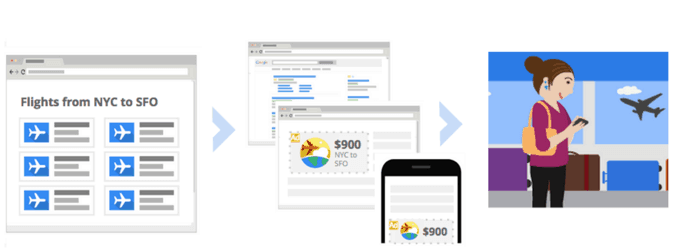How to Make the Google Display Network Work For Your Business
Getting started on a digital marketing campaign?
AdWords is one of the best places to start.
Google processes billions of search queries every single day across all devices. Advertisers can create targeted ads to display in the search results and easily segment their audience accordingly. Ads aren’t just limited to the Search Network though.
Business owners can also advertise on the Display Network, a network that spans over two million websites and reaches over 90% of all online users according to Google. Chances are you have seen Display Ads yourself while browsing some of your favourite sites. These ads are typically found in headers, sidebars or within the content itself.
Advertising on the Display Network can help increase your reach. But a different approach is required to be effective.
Here we look at how to make the most out of the Display Network.
1. Use Remarketing to Bring Visitors Back
Remarketing lets you target visitors who have previously visited your site without making a conversion. These visitors are shown relevant ads as they browse the web.

If a visitor lands on a product page, you could create display ads that are related to the products viewed. Your ad could potentially bring them back to your site to complete their purchase. This is just one example of how remarketing on the Display Network can bring more sales to your business.
You can get started with remarketing by creating a new campaign (choose Display Network only). Then under the Drive Action section, select the first option.

Then select the Interests & remarketing option on the next page to target people who have visited your site.
Your ad is arguably the most important element of your campaign. So spend some time to craft an engaging ad to bring more visitors back to your site.
2. Use Managed Placements
Managed placements give advertisers more control over where their ads display.
With interest or topic targeting methods, your ads are automatically placed on sites that Google deems relevant for your campaign. But if you see that certain sites in the Display Network are performing poorly, you can stop your ads from displaying on them altogether.
You can add, edit or remove managed placements by clicking on the Display Network tab from within a Display Ad search campaign.

Go through your Analytics data before removing any managed placements and be sure to track the performance of any that you add.
3. Create Ads in Different Formats
Different ad formats are available and you should absolutely utilise all of them to your advantage. Some people are more responsive to certain formats than others. So you are far more likely to get responses by experimenting with each.
Here are the formats available for display ads:
Text ads:
Just like with the Search Network, you can also create text ads for the Display Network. These consist of a headline, two lines of text, and a display URL. Test different copy to see which ad performs best.
Image ads:
These consist of static images that typically fill an entire ad block such as in the sidebar or within the content. If you are using remarketing (as you should), the images you create should be specific to these campaigns. Use quality images to engage potential prospects.
Rich media ads:
Rich media ads have interactive elements in them such as animations or other aspects depending on who is looking at the ad. An example would be a carousel of products that viewers can interact with.
Video ads:
YouTube is also part of the Display Network so you could create video ads that play for relevant videos. Creating video ads requires more effort but it can be just as effective.
Utilise each format to increase your reach. But remember to track and monitor each so you can make any changes as necessary.
4. Nurture Your Display Ad Campaigns
Given how display ads are more of a passive form of advertising, it can be tempting to set up your campaigns once and let them run on their own. But the Display Network can still drive a considerable amount of traffic and sales to your landing pages. So you should be spending some time each week to evaluate your account and see what changes you can make to further optimise it.
This includes
- Measuring the performance of each ad format
- Adjusting bids for keywords you are targeting
- Adding or removing managed placements
- Experimenting with different ad copy
- Split testing different ad copy
- Optimising for mobile devices
Measuring and tracking your display ads can help identify hidden opportunities that may otherwise have gone unnoticed. If certain aspects of the campaign are performing better than expected (e.g. retargeting), consider allocating more of your budget to it. Likewise, if a campaign is burning through your budget without any results then either make some changes or remove it altogether.
Follow each of these best practices to make the Display Network work for your business.
